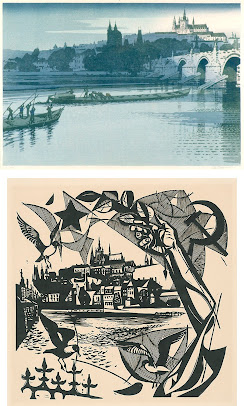Today we’re travelling to Prague, by way of relief block prints. As usual, I’ve found far more pieces than I can comfortably share in one post, so I’m going to split the theme into two. In this post my focus is on pieces that show some of the iconic scenes I saw on my own recent trip to Prague, somewhere I’d been hoping to go for a long time. (I’m also hoping to do a print or two of my own based on some of my photographs, but I don’t know when I’ll get to that.)
First up is a color woodcut by Vladislav Rohling from about 1925. The Wallenstein Garden is in the foreground, and behind it is the Castle up on the mount. I can’t quite interpret how many different blocks went into this (grey, brown, beige, oranges, and greens?), but it looks like most of them were inked with a gradation of color. I like the way all the pale colors at the top give the whole piece a look of hot autumn afternoon sun. The use of grey at the top and brown at the bottom instead of black is very effective.
Next are three pieces by Pavel Šimon, an artist whose work has appeared twice in this blog previously (here and here). His three scenes all date to the middle of the 20th century when Czechoslovakia was under Communist rule, but in these pictures Prague retains a timeless feel. Much of the medieval and baroque architecture in the center of Prague has been little changed from the nineteenth century right up until now, despite all the political upheaval. The first piece is the view from the stairs up to the Castle, in which you can see the dome of St Nicholas Church, and the Charles Bridge with its tower on each end. The second view is almost the reverse: from somewhere near the bridge (perhaps one of the little riverside islands?), looking back past St Nicholas, and up to St Vitus church in the Castle. The third view is Old Town Square across the river, with the the tower of the Old Town Hall and the twin turrets of Týn church. Šimon does a great job with the lights illuminating the city.
Next is a woodcut of the Old Jewish Cemetery by Emil Orlik, dating from the end of the 19th century before the Nazi invasion and the extermination of most of Prague’s Jewish population. This view doesn’t show one of the more iconically crowded sections of the cemetery in which the carved stones are really tumbled together on top of each other, but it does capture the sense of peace and solemnity here.
Speaking of crowded, nowadays you’d be hard put to find a daytime scene of the Charles Bridge with only a few people on it, but this piece by Jaroslav Lukavský dates once again to the Communist era, so there certainly were’t crowds of tourists then. Once again we’ve got the skyline of St Nicholas and St Vitus, but this piece adds the sculptures of Charles Bridge to the mix. It also has a rather different style, more angular and geometric.
The last two pieces are both from the bank of the Vltava looking up toward the Castle, but the first, by John Edgar Platt in 1928, is to the south of the Charles Bridge, while the second, by Vincent Hložník in 1961, places the viewer to the north of the bridge. Platt’s color woodcut appears to have perhaps three different blocks, although I
can’t tell for sure because the colors are similar and the blocks may be inked in gradations. As for Hložník’s linocut, it’s the only one here that makes reference to anything other than the architecture. With its raised hand and hammer and sickle, this is one of a series of block prints celebrating the Constitution of the Czechoslovak Socialist Republic. And yet there’s Prague, enduring as ever despite the politics spinning around it.
Next time I’ll have the work of a Czech artist who made dozens of portraits of Prague.
[Pictures: Untitled, color woodcut by Vladislav Rohling, c. 1925 (Image from Annex Galleries);
Steps to the Prague Castle, wood engraving by Pavel Šimon, 1951 (Image from Frederikshavn Kunstmuseum);
Evening in Mala Strana, woodcut by Šimon, c. 1952;
Old Town Square, Prague, woodcut by Šimon, c. 1952 (Images from TFSimon);
The Old Jewish Cemetery in Prague, woodcut by Emil Orlik, c. 1898 (Image from Annex Galleries);
Prague, woodcut by Jaroslav Lukavský, mid-20th century (Image from Auction Housing Works);
The Vltava at Prague, colour woodcut by John Edgar Platt, 1928 (Image from Department for Culture, Media & Sport);
Praha. Ústava ČSSR - 10, linocut by Vincent Hložník, 1961 (Image from web umenia).]






No comments:
Post a Comment